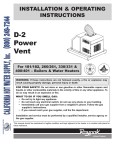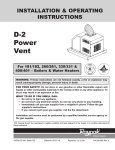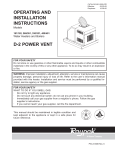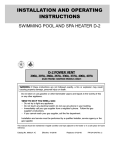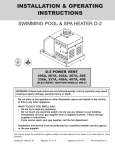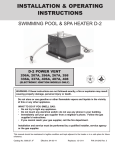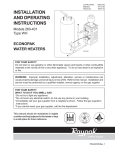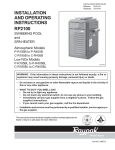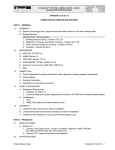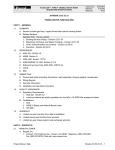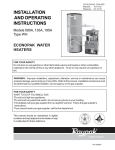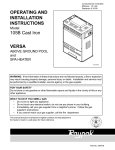Download Raypak Power Vent D2 Operating instructions
Transcript
INSTALLATION & OPERATING INSTRUCTIONS D-2 Power Vent For 181/182, 260/261, 330/331 & 400/401 – Boilers & Water Heaters WARNING: If these instructions are not followed exactly, a fire or explosion may result causing property damage, personal injury or death. FOR YOUR SAFETY: Do not store or use gasoline or other flammable vapors and liquids or other combustible materials in the vicinity of this or any other appliance. To do so may result in an explosion or fire. WHAT TO DO IF YOU SMELL GAS: • Do not try to light any appliance. • Do not touch any electrical switch; do not use any phone in your building. • Immediately call your gas supplier from a neighbor's phone. Follow the gas supplier's instructions. • If you cannot reach your gas supplier, call the fire department. Installation and service must be performed by a qualified installer, service agency or the gas supplier. This manual should be maintained in legible condition and kept adjacent to the heater or in another safe place for future reference. CATALOG NO. 6000.57F Effective: 12-02-08 Replaces: 5-20-08 P/N 241086 Rev. 7 Rev. 7 reflects the following: Changes to: The text in paragraph one of the Venting section on page 8. 2 CONTENTS Warnings 4 Pay Attention to These Terms 4 Receiving Equipment 5 General Specifications 5 Installation 5 Mounting the Assembly 5 Wiring a Power Vent Assembly to an Appliance with IID Ignition 8 Venting 8 Wiring Diagrams 10 182-260 H4/WH1 (Atmospheric) 10 181-261 H4/WH1 (Low NOx) 11 Sequence of Operation 13 Start Up Procedures 13 Draft Proving Switch 13 Illustrated Parts List 14 3 Warnings Pay Attention to These Terms DANGER: Indicates the presence of immediate hazards which will cause severe personal injury, death or substantial property damage if ignored. WARNING: Indicates the presence of hazards or unsafe practices which could cause severe personal injury, death or substantial property damage if ignored. CAUTION: Indicates the presence of hazards or unsafe practices which could cause minor personal injury or product or property damage if ignored. NOTE: Indicates special instructions on installation, operation, or maintenance which are important but not related to personal injury hazards. NOTE: Minimum 18 AWG, 105°C, stranded wire must be used for all low voltage (less than 30 volts) external connections to the unit. Solid conductors should not be used because they can cause excessive tension on contact points. Install conduit as appropriate. All high voltage wires must be the same size (105°C, stranded wire) as the ones on the unit or larger. 4 Receiving Equipment On receipt of your equipment it is suggested that you visually check for external damage to the carton. If the carton is damaged, it is suggested that a note be made on the Bill of Lading when signing for equipment. Remove the complete assembly from the carton if it is damaged report the damage to the carrier immediately. Be sure that you receive the number of packages indicated on the Bill of Lading. Claims for shortages and damages must be filed with the carrier by consignee. Model No. Minimum Connection Diameter Kit Number Factory Wired 181/182 4” 008757 120V 260/261 4” 008757 120V 330/331 4” 008758 120V 400/401 4” 008758 120V Table A: Draft Assembly Application and Kit Numbers Installation Purchased parts are subject to replacement only under the manufacturer's warranty. Debits for defective replacement parts will not be accepted and defective parts will be replaced in kind only per our standard warranties. The equipment must be installed in accordance with local codes, or in the absence of local codes with the latest edition of the National Fuel Gas Code, ANSI Z223.1, the National Electrical Code, ANSI/NFPA 70. When ordering parts, you must specify Model and Serial Number of the unit. When ordering under warranty conditions, you must also specify date of Installation. The equipment shall be installed in accordance with those installation regulations in force in the local area where the installation is to be made. These shall be carefully followed in all cases. Authorities having jurisdiction shall be consulted before installations are made. Raypak recommends that this manual be reviewed thoroughly before installing the D-2 Power Vent. If there are any questions which this manual does not answer, please contact your local Raypak Representative. Mounting the Assembly Follow these instructions if the Power Vent venting system was purchased as an optional assembly kit. THIS MANUAL SHOULD BE MAINTAINED IN LEGIBLE CONDITION AND KEPT ADJACENT TO THE UNIT. 1. Remove existing pagoda top (outdoor units) or drafthood (indoor units). To remove the pagoda top, push the four brackets inward and pull up the pagoda top. The pagoda may then be discarded. General Specifications The D-2 Power Vent Assembly is tested and certified to the latest edition of the American National Standard ANSI Z21.56. standard for pool heaters, Z21.10.3 for water heaters and Z21.13 for boilers. 2. Unscrew the four screws holding the outer top using a phillips screw driver. Remove the jacket top. 3. Replace the inner stack adapter. If the heater had a drafthood installed previously, remove the inner stack adapter and replace it with the Power Vent stack adapter. Otherwise, install the Power Vent stack adapter. The Power Vent Assembly is a fan assisted combustion system designed for application to Raypak Heater Models 181-401. The unit, when installed as directed, is capable of operating in applications such as through the wall venting and reduced horizontal and vertical vent pipe sizes in new and existing installations. 4. Unscrew the access panel on the right side of the appliance. Set aside the screws with the access panel. The D-2 Power Vent assembly includes a blower with a 120/240 volt 60 Hz 1.0/1.95A 3200 RPM motor, a plenum complete with a draft proving switch and a motor relay. When provided for field mounting the assembly is equipped with a wire harness. 5. Remove the knurled screw holding the front door and set it aside with the door. 6. Mount the jacket top above the unit. Note: Do not install at this point. 5 7. Mount the Power Vent on the outer top. TABS 8. Route the conduit harness of the Power Vent thru the outer top hole, around the adapter towards the back of the unit. Continue routing the harness thru the corner slot, which leads to open area behind the access panel. Finally, route only the wire harness thru the 7/8” grommet hole located on the sway brace. Follow instructions on page 7 to wire the Power Vent. Note: Newer units have a 7/8” grommet located on the rain shield, which would eliminate routing the harness around the back corner. BEFORE 9. Re-mount the jacket top to its original position and screw in the four screws holding it down to the appliance. Fig. 1: Reposition the Tabs as Necessary (see step 10) to hold the Power Vent in position. Note: While twisting you may notice some roughness, this is due to a tight seal between the 6” vent and the Power Vent flue box. 10. If the appliance is a 181, 182, 330 or 331, remove the tabs underneath the power vent using a 5/16” nut driver and relocate them closer to the center of the Power Vent as shown in Fig. 1. 12. Re-mount the access panel. 11. Mount the Power Vent assembly bottom on the 6” vent as shown below. Twist the assembly downward. Snap the mounting brackets into their appropriate slot EXHUAST OUTLET AFTER 13. Re-mount the front door along with the knurled screw on the heater. TOP VIEW REAR VIEW LEFT SIDE Note: The 90° elbow may be used as a termination cap. Fig. 2: Draft Assembly 6 FRONT VIEW Fig. 3: Minimum Clearances from Vent/Air Inlet Terminations – Indoor and Outdoor Installations 1 1 2 t TT * 2 U.S. Installations Canadian Installations A Clearance above grade, veranda, porch, deck, or balcony 1 ft (30 cm) 1 ft (30 cm) B Clearance to window or door that may be opened 4 ft (1.2m) below or to side of opening; 1 foot (30 cm) above opening 3 ft (91 cm) C Clearance to permanently closed window * * D Vertical clearance to ventilated soffit located above the terminal within a horizontal distance of 2 ft (61cm) from the centerline of the terminal 5 ft (1.5m) * E Clearance to unventilated soffit * * F Clearance to outside corner * * G Clearance to inside corner 6 ft (1.83m) * H Clearance to each side of center line extended above meter/regulator assembly * 3 ft (91 cm) within a height 15 ft above the meter/regulator assembly I Clearance to service regulator vent outlet * 6 ft (1.83m) J Clearance to non-mechanical air supply inlet to building or the combustion air inlet to any other appliance 4 ft (1.2m) below or to side of opening; 1 ft (30 cm) above opening 3 ft (91 cm) K Clearance to mechanical air supply inlet 3 ft (91 cm) above if within 10 ft (3m) horizontally 6 ft (1.83m) L Clearance above paved sidewalk or paved driveway located on public property 7 ft (2.13m) 7 ft (2.13m) t M Clearance under veranda, porch, deck or balcony * 12 in. (30 cm) TT In accordance with the current ANSI Z223.1/NFPA 54 National Fuel Gas Code In accordance with the current CAN/CGA-B149 Installation Codes Vent terminal shall not terminate directly above sidewalk or paved driveway located between 2 single family dwellings that serves both dwellings Permitted only if veranda, porch, deck, or balcony is fully open on a minimum of two sides beneath the floor and top of terminal and underside of veranda, porch, deck or balcony is greater than 1 ft (30cm) Clearances in accordance with local installation codes and the requirements of the gas supplier Table B: Vent/Air Inlet Termination Clearances 7 Wiring a Power Vent Assembly to an Appliance with IID Ignition 90 Degree Elbows WARNING: Disconnect all electrical power to the unit before servicing to avoid potential shock injury or damage to the unit. To change voltages, follow wiring diagram for correct voltage connections. Improper wiring connections can burnout the relay and blower motor. 45 Degree Elbows Quantity Maximum Length (ft) Quantity Maximum Length (ft) 1 30 1 35 2 20 2 30 3 10 3 25 Table C: Reduced Maximum Equivalent Vent Run 4" DIAMETER Venting The vent pipe must be the same size or one size larger than what is indicated. The D-2 Power Vent is capable of 360-degree discharge rotation and operates with a positive vent static pressure and with a vent gas temperature less than 400°F. The total length of horizontal run shall not exceed an equivalent of 40 feet including termination cap. For all cases, each 90-degree elbow reduces the maximum horizontal vent run by 10 feet and each 45-degree elbow in the vent run reduces the maximum vent run by 5 feet. See the table below for maximum vent lengths using 90-degree and 45-degree elbows. The D-2 Power Vent uses positive pressure to push flue gases through the vent pipe to the outside. The vent must be installed to prevent flue gas leakage. Care must be taken during assembly to ensure that all joints are sealed properly and are airtight. LEFT SIDE Fig. 4: Draft Assembly The vent must be installed to prevent the potential accumulation of condensate in the vent pipes. It is recommended that: The Raypak Power Vent operates with a positive vent static pressure and with a vent gas temperature that avoids excessive condensate production in the vent and as such it is listed as a CATEGORY III appliance. a) The vent be installed with a slight downward slope of not more than 1/4” per foot of horizontal run to the vent terminal. Exception: When a Power Vent is connected to a vertical vent of sufficient height to generate a negative draft in the system. Consult sizing guide or factory. b) The vent be insulated through the length of horizontal run. For appliances installed in extreme cold climate, it is recommended that: The D-2 Power Vent assembly is suitable for through the wall venting, and for connection to smaller size vent pipes and breeching other than the standard atmospheric heater. a) The vent be installed with a slight upward slope of not more than 1/4” per foot of horizontal run to the vent terminal. In this case, an approved condensate trap must be installed per applicable codes. b) The vent be insulated through the length of the horizontal run. 8 LEFT SIDE Fig. 5: Through the Wall Vent The D-2 Power Vent assembly includes a wire harness, shown in Fig. 6 below, which provides quick connections with the respective controls in the heater control box. The harness is of sufficient length to fit the appliance for which it is sized. Reference the wiring diagram supplied with each appliance for actual connections. RELAY Y/BK V/BK Y/BK Y/BK GAS VALVE V/BK PRESSURE SWITCH V/BK V/W V/W Fig. 6: D-2 Power Vent Wire Harness 9 Wiring Diagrams—182-260 H4/WH1 (Atmospheric) 10 181-261 H4/WH1 (Low NOx) 11 Model No. A 181 18.13 B C D 7.88 4.25 181 18218.13 18.13 12.38 7.88 12.38 4.25 7.88 182 26018.13 18.13 12.38 7.88 12.38 4.25 7.88 4.25 Dimensional Data 261 18.13 12.38 7.88 4.25 260 18.13 12.38 7.88 4.25 330 17.50 15.75 7.63 261 18.13 12.38 7.88 4.25 6.00 331 330 40017.50 331 40117.50 400 401 12.38 4.25 17.50 15.75 7.63 6.00 17.50 15.75 7.63 7.63 6.00 15.75 6.00 7.63 7.63 6.00 15.75 17.50 15.75 6.00 Table D: Dimensional Data 17.50 15.75 7.63 17.50 15.75 7.63 6.00 6.00 12 Sequence of Operation 9. Heater will operate until call for heat is satisfied. On call for heat, the D-2 Power Vent fan (and appliance pump) start. When the flow switch circuits close, the ignition system consisting of an electronic spark module, pilot gas system and flame sensor, are energized. When draft proving switch closes and all safety circuits are proven, the automatic main gas valves will open and the heater will operate. When the operating limit circuit is satisfied, the heater will shut down. 10. Restart unit and visually check all components for proper operation. 11. Check all vent connections and joints for leakage. Correct if found. 12. To restart unit after a failure, follow the procedures outlined above and other subsequent or related sections outlined in the heater manual. Start Up Procedures EMERGENCY SHUTDOWN: SHUT OFF POWER AND GAS, CALL GAS UTILITY. The water system, the gas system and the electrical system for the heater should be completed and checked as per the heater installation manual and associated documents. ALL Draft Proving Switch The draft proving switch insures that the blower is operating. The switch is in the limit circuit and does not allow the ignition module to operate unless it is closed. 1. Turn on power to the heater with the manual main gas valve and pilot gas valve off. The electric power supply requirements are: a. Dual-voltage fan motor. 120/240 volt 60Hz 1.0/1.95 Amp fan motor for models 181-401. NEGATIVE PRESSURE CONNECTOR 2. Check power connections. 3. Close heater power switch. 4. Set operating control to call for heat. a. Fan motor starts, draft proving switch closes. b. Heater pump starts, flow switch closes. c. Ignition module energized. d. Check for spark at gas pilot. 5. Turn operating control to end call for heat. 6. Wait a minimum of 60 seconds. 7. Open pilot gas valve. a. Repeat procedure outlined in #4 above. Fig. 7: Draft Proving Switch 8. After pilot gas is proven and main safety shut-off valve is energized. a. Main burners will ignite. 13 Illustrated Parts List 4 9 10 5 11 1 6 3 2 15 7 12 13 14 8 Call Out 1 2 3 4 5 6 7 8 9 10 11 12 13 14 15 Description Power Vent Relay Power Vent Blower Power Vent NO Pressure Switch Elbow 4"-90° with Screen Power Vent Flue Box Power Vent Base Assembly Power Vent Flue Collar Power Vent Flue Adaptor Power Vent 4" Flange Power Vent Blower Adaptor Power Vent Control Cover Power Vent Control Swaybrace Power Vent Silicone Hose Power Vent Front Panel Blower Cooling Fan 14 181-261 008784F 008156F 008062F 010827F 008682F 008684F 008686F 008687F 008689F 008690F 008691F 008692F 008693F 008694F 011549F 331-401 008784F 008156F 008135F 010827F 008683F 008685F 008686F 008688F 008689F 008690F 008691F 008692F 008693F 008694F 011549F 15 www.raypak.com Raypak, Inc., 2151 Eastman Avenue, Oxnard, CA 93030 (805) 278-5300 Fax (805) 278-5468 Litho in U.S.A.
















